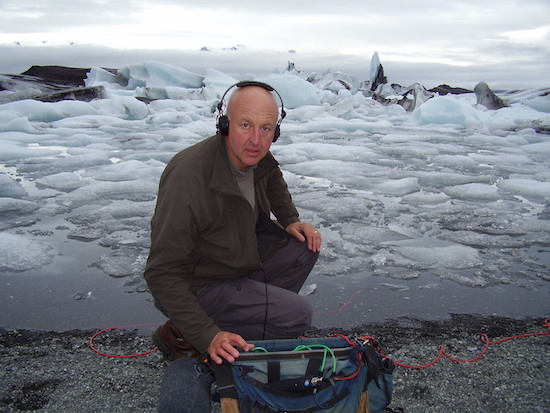Photo by Chris Watson
When Chris Watson travelled by the Oxmardyke rail crossing in 2017, he found its sound to be enticing. So, he returned to the place for a few weeks, gathering new tape with each excursion. These field recordings sound of industry and nature in harmony – as trains rush by and birds swarm around them, chirping through the metallic scratches and gusts of wind and dust. He later sent these recordings to his friend Philip Jeck, who took them and transformed them using his laptop, creating impressions of the place through tactile sound. Jeck’s resulting mix, Oxmardyke, finds a careful balance between the two artists’ quintessential styles, mixing Watson’s crisp field recordings and Jeck’s broad-stroked swaths of sound.

Photo of Philip Jeck live in Turin by Jon Wozencroft
Jeck and Watson, both mainstays of the Touch record label catalogue, were longtime friends. In his liner notes accompanying the release, Watson remembers how he and Jeck got to know each other over drinks at the Philharmonic Dining Rooms, indulging in a good bit of merriment but also discussing making music together someday. After one post-show conversation about the sound and history of the area around the Oxmardyke crossing, it was clear that Watson’s Oxmardyke rail crossing recordings could be a good fit for uniting their visions, particularly blending Watson’s interest in recording the world with precision and Jeck’s curiosity about how the past may still haunt the present.
Oxmardyke came to fruition just before Jeck’s untimely passing in 2022, during moments in which his pain subsided enough that he could work on his laptop. The music he makes here reflects his classic textural sound and collaborations like 2021’s Stardust, in which he distorted recordings made by Faith Coloccia that revolved around motherhood. To make Oxmardyke, he took the sounds Watson captured – many different bird calls and metallic screeches of passing freight trains – and toyed with them, ultimately creating eerie music. Jeck’s penchant for vivid sound bolsters Watson’s keen eye for the most affecting sounds of nature, unearthing the emotions hidden inside of them.
Place feels both literal and metaphorical on Oxmardyke. When thinking about this music, Watson cites JMW Turner’s Rain, Steam and Speed as an inspiration; the painting depicts the clash of nature and industry in sullen earth tones, not unlike the recordings he captured. Jeck cites Oxmardyke’s history of the Knights Templar of the sixth century; he imagines their ghosts still floating around the place. The music often feels reminiscent of these artefacts, playing with the push and pull between past and present and electronics and nature, but much of the album’s sounds are razor-sharp, made of pointed strokes that carve out the edges of each image they create. In an interview with Ged Barry, Jeck noted that he likes to paint with sound; in practice, his music mixes colours together to create sweeping odes. Here, the hues he chooses often feel dark, reminiscent of the long-gone history that inspired him, while pristine fragments of the field recordings pop in and out of the fold.
The balance between cinematic sound and intricate detail is most evident on tracks like ‘AH’, where a chorus of birds, trilling in high pitched calls to each other, give way to a pulsing siren. It’s an ominous track: rolling, percussive sounds give way to thunderous swaths of sound that often feel alarming. But when those electronic noises pull away, what’s left is chattering birds. You might imagine the serenity of watching them fly above you or pick at the grass nearby. Elsewhere, razor-sharp sounds slice through Watson’s recordings, disrupting the placid landscapes he captured. Tracks like ‘Bridge’, which is glassier, still features piercing metallic scrapes that slice and shock; the music is never in one place for too long, as jarring moments disrupt every silence, bringing with them a harrowing feeling.

Photo of Chris Watson by Kate Humble
While Oxmardyke is layered and intricate, there’s a sense of hollowness and ominousness that rings throughout. The phrases that interweave and braid together on each track often fade out, leaving a hole in their wake. Tracks like ‘Barn’ sound cavernous – the music here is made of rounded pulses and some shrill squeals that circle around them, but when they disappear, all that’s left is a sense of lamentation. ‘Drum’ builds from a glossy surface, only to fall away into a bunch of shards that splinter like broken glass. It evokes both fear and appreciation, like how beauty and destruction go hand-in-hand when outside.
But perhaps the most moving moments are those in which the music leaves space for quiet reflection. Nowhere is nostalgia stronger than on the closer ‘Spurn’, which drops us in what feels like a peaceful setting of birds and gentle breezes. In contrast, fiery drones circle around them, creating a filmy sound that almost drowns out the recordings – but not quite. It’s as if an idea is just coming in and out of focus; it’s almost complete, but a few pieces are missing. When the track cuts out, all that’s left is the feeling of a memory that’s almost close enough to grasp, yet too far away to hold.



